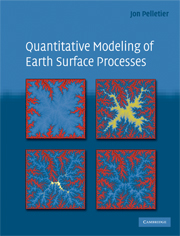Book contents
- Frontmatter
- Contents
- Preface
- Chapter 1 Introduction
- Chapter 2 The diffusion equation
- Chapter 3 Flow routing
- Chapter 4 The advection/wave equation
- Chapter 5 Flexural isostasy
- Chapter 6 Non-Newtonian flow equations
- Chapter 7 Instabilities
- Chapter 8 Stochastic processes
- Appendix 1 Codes for solving the diffusion equation
- Appendix 2 Codes for flow routing
- Appendix 3 Codes for solving the advection equation
- Appendix 4 Codes for solving the flexure equation
- Appendix 5 Codes for modeling non-Newtonian flows
- Appendix 6 Codes for modeling instabilities
- Appendix 7 Codes for modeling stochastic processes
- References
- Index
- Plate section
Preface
Published online by Cambridge University Press: 05 June 2012
- Frontmatter
- Contents
- Preface
- Chapter 1 Introduction
- Chapter 2 The diffusion equation
- Chapter 3 Flow routing
- Chapter 4 The advection/wave equation
- Chapter 5 Flexural isostasy
- Chapter 6 Non-Newtonian flow equations
- Chapter 7 Instabilities
- Chapter 8 Stochastic processes
- Appendix 1 Codes for solving the diffusion equation
- Appendix 2 Codes for flow routing
- Appendix 3 Codes for solving the advection equation
- Appendix 4 Codes for solving the flexure equation
- Appendix 5 Codes for modeling non-Newtonian flows
- Appendix 6 Codes for modeling instabilities
- Appendix 7 Codes for modeling stochastic processes
- References
- Index
- Plate section
Summary
Geomorphology is undergoing a renaissance made possible by new techniques in numerical modeling, geochronology, and remote sensing. Advances in numerical modeling make it possible to model surface processes and their feedbacks with climate and tectonics over a wide range of spatial and temporal scales. The Shuttle Radar Topography Mission (SRTM) has mapped most of Earth's topography at much higher spatial resolution and accuracy than ever before. Cosmogenic dating and other geochronologic techniques have provided vast new data on surface-process rates and landform ages. Modeling, geochronology, and remote sensing are also revolutionizing natural-hazard assessment and mitigation, enabling society to assess the hazards posed by floods, landslides, windblown dust, soil erosion, and other geomorphic hazards.
The complexity of geomorphic systems poses several challenges, however. First, the relationship between process and form is often difficult to determine uniquely. Many geomorphic processes cannot be readily quantified, and it is often unclear which processes are most important in controlling a particular geomorphic system, and how those processes interact to form the geomorphic and sedimentary records we see today. Terraces and sedimentary deposits on alluvial fans, for example, are controlled by climate, tectonics, and internal drainage adjustments in a way that geomorphologists have not been able to fully unravel. Second, surface processes are strongly influenced by fluid motions, and most classic geomorphic techniques (e.g. field mapping) are not well suited to quantifying fluid dynamics and their interactions with the surface.
- Type
- Chapter
- Information
- Quantitative Modeling of Earth Surface Processes , pp. ix - xiiPublisher: Cambridge University PressPrint publication year: 2008



